Review: ICM 1/48 B-26K Counter Invader
The Airplane:
Designed by Douglas Aircraft's legendary Ed Heineman as a replacement for the A-20, the A-26 Invader was almost 150 percent larger than the earlier design. Powered by two R-2800s and using a laminar-flow wing, the aircraft had good speed and maneuverability, as well as load carrying ability. It entered production in mid-1944 and soon re-equipped units flying the Martin B-26 Marauder in the ETO before arriving in the Far East where it replaced A-20s in light attack squadrons. It benefited from all the work the legendary Pappy Gunn had done in creating the “gunship,” and was used primarily in ground attack with armament that included .50 caliber machine guns mounted in six and eight-gun noses.
In Korea, the B-26B gunship and B-26C bomber wee used for night time interdiction of North Korean supply routes. The aircraft was also supplied to France, where it was used in Indochina and later in counter-insurgency efforts in French North Africa. In 1960, the CIA provided B-26s to the Laotian Air Force during the Laotian civil war. A year later, the B-26's from Lao were taken over by the USAF and provided to the Viet Nam Air Force (VNAF), with US crews to train Vietnamese under the Farm Gate program that eventually saw the US crews taking the primary operational role.
By this point, the B-26s were old and tired, and they started suffering wing failure in February 1964. B-26 aircraft used by USAF Commandos in Vietnam were grounded on April 8, 1964. The Air Force began an upgrade to reinforce the main spars and provide additional operational life, but it was determined that more extensive work was necessary. The B-26, with its long loiter time and heavy armament, was an excellent counter-insurgency weapon in an environment where there was no modern aerial opposition.
In response to this, the On Mark Engineering Company of Van Nuys, California, was selected by the USAF to extensively upgrade the B-26 for its new counterinsurgency role. The first production flight of the B-26K was on May 30, 1964 at the Van Nuys Airport. On Mark converted 40 Invaders to the new B-26K Counter-Invader standard of rebuilt, strengthened wings, enlarged tail assembly, new R-2800-103W engines with reversible propellers/propeller spinners modified from DC-7 propellers, dual controls, wingtip tanks, newer avionics, and increased hardpoint/armament enhancements, for use by the 609th Special Operations Squadron. In May 1966, the B-26K was again redesignated A-26A for political reasons since Thailand did not allow U.S. bombers in-country at the time, so the Invaders were redesignated with an "A", for attack aircraft, and deployed in Thailand to help disrupt supplies moving along the Ho Chi Minh trail.
The CIA contracted anti-Castro Cuban pilots, some employed during the Bay of Pigs Invasion, to fly B-26Ks for ground attack against Katangan rebels in the Congo Crisis. Ten newly remanufactured B-26K Counter-Invaders were delivered to the Congo via Hurlburt Field in 1964.
The B-26s operated over the Ho Chi Minh Trail where it exited North Vietnam into the “panhandle” of southern Laos at the Mu Gia Pass in what was known as Operation Steel Tiger. The section of the trail in Laos between Mu Gia Pass and where the trail turned back into northern South Vietnam did not have such heavy anti-aircraft defense as the section inside Vietnam. Armed with eight .50 caliber machine guns in the nose and carrying up to 8,000 pounds of ordnance in the internal bomb bay and the eight underwing hard points, the Counter Invader was extremely effective in trail attacks against truck convoys. The B-26s were equipped with AN/PVS2 Starlight scopes for enhanced nighttime visibility.
However, the operations “across the river” (the Mekong River dividing Laos from Thailand) in Laos were violations of the 1964 Laos peace accords to which both the U.S. and the Democratic Republic of Vietnam were signatory, and the B-26s carried no national insignia and crews did not carry identification.
By the summer of 1968 the night interdiction missions had been gradually taken over by the AC-130A and AC-130E gunships and the Counter Invaders were phased out of active service. Losses were heavy, 12 of the 30 aircraft deployed to Nakhon Phanom RTAB in 1966 had been lost by 1968. No crew lost over Laos was ever returned to U.S. control. In 1967, personnel of a Long Range Reconnaissance Patrol (LRRP) unit reported seeing a B-26 crash. The crewmen were quickly taken prisoner by Pathet Lao guerillas, who immediately executed them by beheading with machetes.
The last A-26A/B-26K Invaders were returned to the US in 1969. This final version continued in service through 1972 with TAC-controlled special-operations units of the Air National Guard.
The A/B-26 Invader was the last propeller-driven twin-engine bomber produced for the USAAF, and was one of the few wartime aircraft kept in service with the post-war USAF. It was the only American bomber to fly in World War II, Korea and Vietnam.
The Kit:
The B-26 Invader has been a popular subject for models since Monogram released a “box scale” plastic kit in 1955, of which your reviewer built many. In the 1960s, Airfix released a 1/72 B-26 that was the industry standard until the 1990s when Italerei released a series of 1/72 B-26s to more modern production standards. In the 1990s, Monogram released the B-26B and B-26C in 1/48; this was a kit originally designed in the 1970s to that era's production standard, that was finally released when Monogram escaped the control of AMT. The kit was also released as a fire bomber in concert with the Steven Spielberg movie “Always”, a remake of his favorite World War II flying movie, “A Guy Named Joe.”
The ICM B-26 was first released as a B-26B-50-DL Korean War era bomber in 2019. The kit is state of the art and the most accurate B-26 kit released. However, the gun nose is noticeably shorter than it should be. This has been corrected by Vector Resins with a series of 6-gun and 8-gun noses which are of excellent quality
and solve the problems. A World War II-era B-26B was released in late 2029, a B-26C with the “bombardier nose” in early 2020 and the B-26K in 2021. A later release in 2022 includes crew figures.
I obtained my kit in early 2022. I then waited to get hold of a Vector Resins resin nose, Vector props, Reskit resin wheels, and the Eduard photo-etch interior. If accuracy is important, the resin nose is crucial for correcting the nose, which is a scale 12 inches short using the kit parts (in other words, "noticeable"). The resin props are necessary to correct the kit parts which have incorrect spinners, and the resin wheels are important since they have the correct shape and tread for the Boeing 707 wheels used by the B-26K. All these parts are really excellent and enhance the final look.
With a “critical mass” of aftermarket parts on hand, I finally decided to plunge into building the kit during the 2022 Christmas holidays.
Construction:
I started by doing as much preparatory painting as possible prior to starting construction. The interior of the cockpit and rear compartment parts were painted black using Tamiya “NATO Black.” The gear wells and interior of the gear doors were painted with my Tamiya mixture for Interior Green.
I first assembled the wings and engine nacelles, leaving off the front of the nacelles so I might add extra weight if needed for nose sitting. I also attached the gear legs in position at this point.
The engines are little models in their own right, and anyone who wanted to do a servicing diorama has all they need to start that with what's provided. If you're not doing that, the only part of the engines you're going to see once inside the deep cowlings is the front. I concentrated on that.
I assembled the cockpits, using the Eduard photo etch detail parts for instrument panels, “black box” faces, seatbelts. I was going to do all the numerous levers on the centerline panel, but when three of the photoetch levers went flying into the air to land I know not where, I decided not to do that and that I would not cut open the canopy to display it open.
I attached the Vector Resin nose pieces in halves to each fuselage half before further assembly and filled the interior with fish weights. I then assembled the rest of the fuselage. Taking care in the process, I was able to do this without needing filler for seams, merely needing to lightly sand the centerline seams. I closed the bomb bay doors since the kit did not provide correct Vietnam-era bombs for the load.
I attached the tail parts to the fuselage, and then slid the wings onto the spars and checked the weight situation. Eveything seemed fine with the weights in the nose, but I added a few more nose weights to the part for the front of the nacelle, then attached it and then completed the engine assembly, attaching the engines and sliding the cowling over them.
The kit was ready to go to the paint shop.
Painting and Decals:
I painted the model in the three-color SEA scheme, using Tamiya “Flat Earth,” “Flat Green” and “Black Green,” “sun fading” them. The lower surfaces were painted with “NATO Black” then lightened with some “German Grey” added.
I used the kit decals to do “Mighty Mouse,” mostly because I liked the Chuck Jones “Roadrunner” cartoon character for the nose art.
Final Assembly:
I applied exhaust staining using Tamiya “smoke.” I unmasked the canopies, then attached the wings, robber-banding them around the engine nacelles to get a tight fit against the fuselage. When that had set, I attached the wheels and the props.
I gave the model an underwing load of “snake and nape,” a standard loadout for operations over the trail, carrying two BLU-23 and two BLU-27 finned napalm tanks, two LAU-69A rocket tubes, and two Mk 82 500lb “Snakeye” bombs with extended fuses.
Overall:
I have liked the B-26 well enough to have made several of every kit of the airplane released since my childhood. The ICM kits are hands-down the nicest of all. The short noses are a bit of a PITA, but it depends on how much outline accuracy you want as to whether you get the resin replacement parts. Vector Resins, which are made in Russia by Sergei (who is a certified “good guy” if dealing with Russians is problematic), and are available in limited numbers at Linden Hill Imports.
The model is not difficult if you follow the instructions and take your time in assembly.
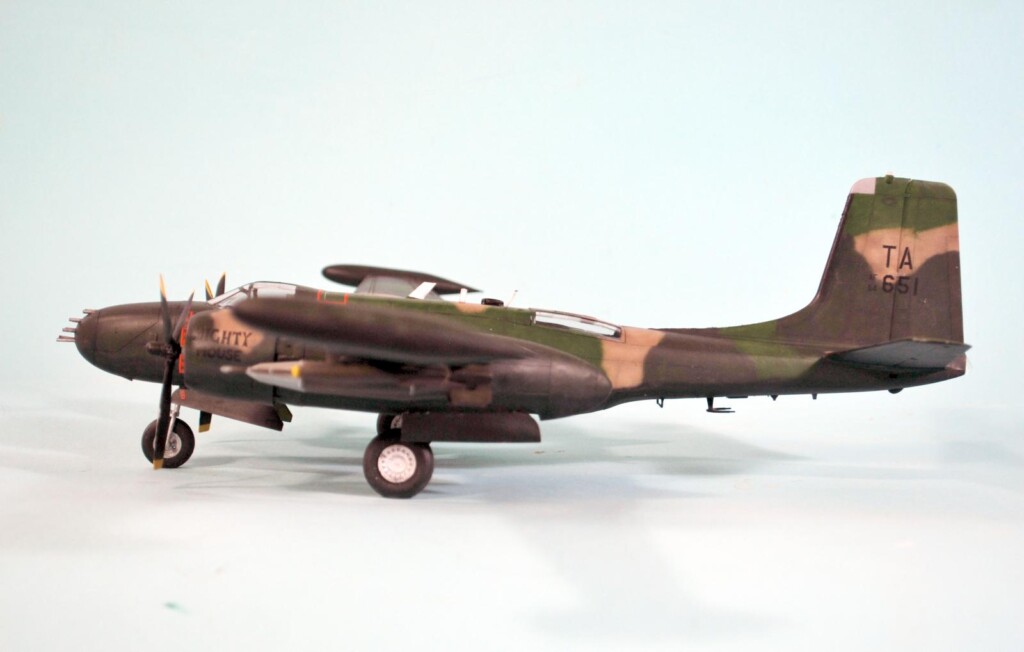
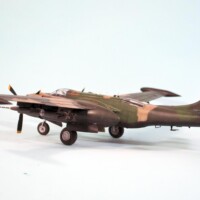
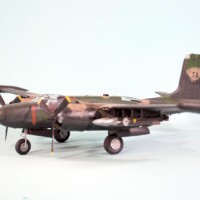
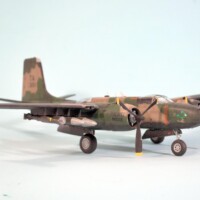
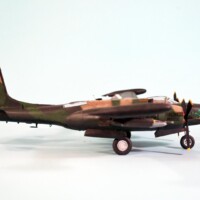
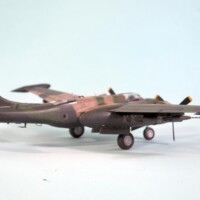
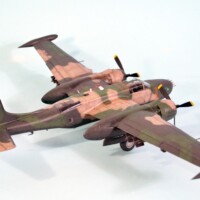
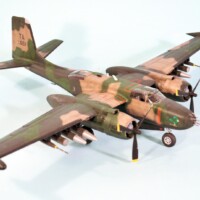
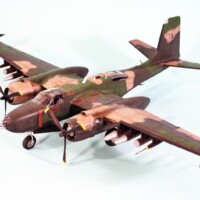
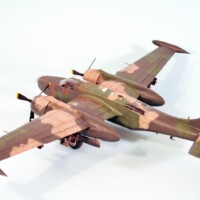
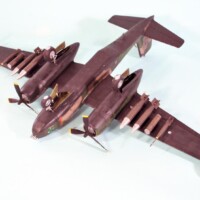
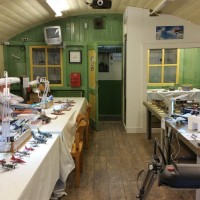
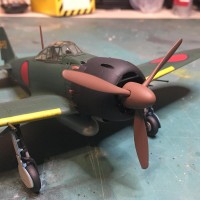
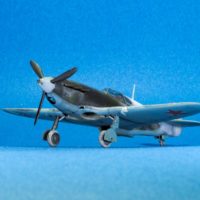
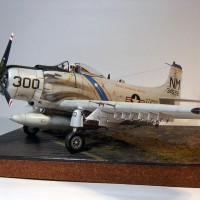
Nice build Tom!
I now wish for this version in 1/32.
Amazing build and ditto article, Tom!
Another great build, Tom @tcinla
Ed Heineman did an amazing job developing this aircraft.
The Tamiya "smoke" effect does look very nice, as well as the entire model.
Great article as well, thanks for sharing.
Great read and build Tom The COIN version is on my list
The COIN version is on my list
Nice job, Tom. Really like the camo paint job, enjoyed your write-up, and it sure looks like that B-26 could pack a punch!
You did a really nice job on this, Tom! That’s one attractive model.
Nicely done, Tom. I really like the paint job.

Excellent build Tom- really like the look of these. Considering getting one of these ICM kits this year to build. Yours is a real beauty.
Excellent work and history - as always! I really like the camo job!
I like this, especially the camo scheme.
Great build and backround information Tom, @tcinla. It is really a beautifully designed plane, and yours looks great in the SEA Camo. I have this kit in the original boxing for the Korean War. I guess I will be on the look out for the Vector Resin nose.
Really great job once again Tom. Of special note is the correct weapons load out. Most "wannabe" experts think that the "Snake" in "Snake and Nape (or Shake and Bake)" is just a Mk 82 with a fuze extender. The fuze extender has nothing to do with the appellation. The "Snake" comes from combining the Mk 15 High Drag fin with the standard Mk82 GP bomb...hence the Snake Eye. The fuze extender gives the bomb a special "flavor", ie, a semi-air burst on impact.
Great looking build, The Invader to me looked more modern than it was.
Excellent research and nice result.
Nicely done, Tom (@tcinla). This is certainly a great kit, and you have produced a great model. These planes had not been retired long when I entered the Air Force. I remember being at Hurlburt Field in Florida for some training, and seeing one of these. I was really impressed at the time with the firepower.
Great read and build Tom, this is a very nice looking Invader.
There is something to be said about getting Resin goodies; "I obtained my kit in early 2022. I then waited to get hold of a Vector Resins resin nose, Vector props, Reskit resin wheels, and the Eduard photo-etch interior. If accuracy is important, the resin nose is crucial for correcting the nose, which is a scale 12 inches short using the kit parts (in other words, "noticeable"). The resin props are necessary to correct the kit parts which have incorrect spinners, and the resin wheels are important since they have the correct shape and tread for the Boeing 707 wheels used by the B-26K".
Good to see a Ukrainian modeling company develop and make a kit that no current kit manufacture would touch. Odd to see a correction set made by a Russian. We live in interesting times.
Some strong work in the paint department. Some of your best work TC.
The article as always is in a league of its own.